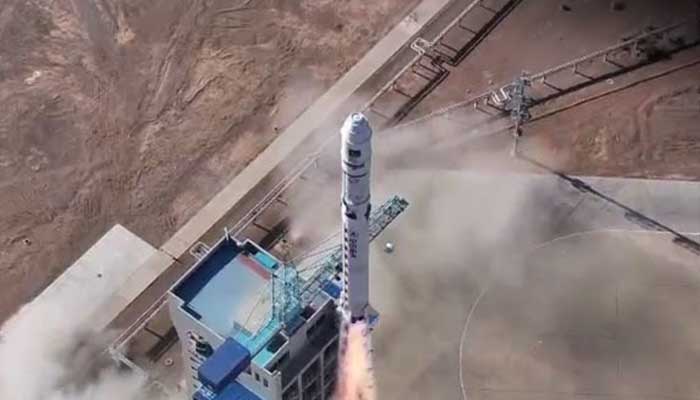
- The in-orbit tests will last up to two months, says Suparco.
- HS-1 will be fully operational once the tests are completed.
- This is the third satellite launched this year after EO-1 and KS-1.
KARACHI: Pakistan launched its first hyperspectral satellite HS-1 from China’s Jiuquan Satellite Launch Center (JSLC), with live footage of the mission broadcast from the Karachi complex of the Space and Upper Atmosphere Research Commission (Suparco), the space agency said.
Preparations for the launch were completed in the presence of Pakistani scientists and engineers.
A Suparco spokesperson said the hyperspectral satellite successfully entered its orbit. It may take up to two months to complete the satellite’s in-orbit testing; After two months, HS-1 will be fully operational, the spokesperson added.
According to the spokesperson, HS-1 will conduct detailed analyzes of land, vegetation, water and urban areas. The advanced satellite is capable of capturing precise images in hundreds of spectral bands and is expected to revolutionize agricultural planning and environmental monitoring.
It will help monitor deforestation, pollution and melting glaciers, and help identify geological risks in CPEC projects, the spokesperson said.
Suparco Chairman Muhammad Yousuf Khan extended his congratulations to the nation, the spokesperson added, noting that the national project was made possible with the support of the Government of Pakistan.
The mission marks an important step towards Pakistan’s self-sufficiency in space technology, and HS-1 will place the country among emerging space leaders for sustainable development, the spokesperson said.
The spokesperson described the mission as an important milestone in Pakistan’s National Space Policy and Vision 2047.
In a statement, the Ministry of Foreign Affairs (FO) said that the successful launch of HS-1 from the China Satellite Launch Center is an important milestone and highlights the long-standing collaboration between Pakistan and China in the peaceful exploration of space.
The FO noted that HS-1 carries advanced hyperspectral imaging capable of capturing data across hundreds of narrow spectral bands. It will also contribute to development initiatives, including CPEC, by identifying geographical hazard risks and supporting sustainable infrastructure development, the statement added.
Deputy Prime Minister and Foreign Minister Ishaq Dar praised Pakistani and Chinese scientists and technical teams working on HS-1 for their commitment, professional excellence and exemplary cooperation, the MoFA said.
This is Pakistan’s third satellite launched into space this year, according to Suparco. The Suparco spokesperson said that the previous missions EO-1 and KS-1 were successfully launched and are fully operational in orbit.
Pakistan’s space program, the spokesperson said, is entering a new era of advanced technology and applications.
The agency framed the mission as a giant leap in Pakistan’s space journey, ushering in advanced applications in agriculture, disaster management, urban planning and environmental monitoring.
In agriculture, HS-1 hyperspectral imaging is intended to enable precision agriculture through high-resolution data and calibration. By providing detailed information on crop health, soil moisture and irrigation patterns, HS-1 is expected to improve yield estimation by 15% to 20%, strengthening food security.
For urban development, HS-1’s sensors will help monitor environmental changes, map infrastructure and analyze urban growth trends. Its ability to capture the spectral signatures of artificial structures aims to support sustainable urban planning, efficient resource management and informed land use policies.
In terms of environmental monitoring and disaster management, the satellite will support early warning and rapid response. Its imagery is intended to assist in flood prediction, landslide detection and geographic hazard assessment, particularly along the Karakoram Highway and northern regions.
The data will also improve post-disaster assessments, transportation network analysis and water resources modeling, providing timely information on floods, earthquakes, deforestation and land degradation.
HS-1 will be integrated with Pakistan’s growing remote sensing fleet, PRSS-1 (launched July 2018), EO-1 (January 2025) and KS-1 (July 2025), to strengthen national space infrastructure and data capabilities.
The mission aligns with Suparco’s National Space Policy and Vision 2047, which seek to position Pakistan among leading space nations and drive sustainable national development through science and innovation.



